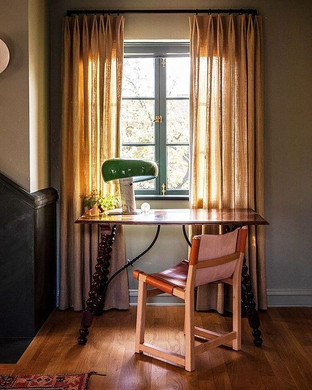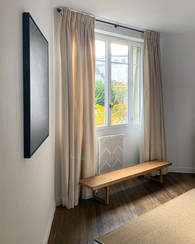It has taken me an age and a half to write part two of this blog, so I do apologise if there is anyone out there who had to guess the rest when it came to curtains, or those who opted to install only roman blinds because I left you hanging on the topic.
Like I mentioned in part one, there is no one size fits all approach with window treatments, and when it comes to curtains that really isn't an understatement. To a certain degree every window needs to be rationalised independently to achieve the best result, and what works in one room and for one window may not work for another.
In short it's a hell of a tricky topic to write about.
I've explained the angle I'm taking with this series in the previous blog, so if you haven't yet read part one, read the first few paragraphs and you'll get the gist, and the rest of what I'm about to write will make more sense.
Basically this blog is more about the things I always keep in mind when it comes to curtains, and less about the jargon and technical bits. It is ultimately up to you if you're going to get somebody in to do your curtains, or if you're heading down the DIY route. I'm not here to judge, and hopefully this blog works for both camps.
However with that being said, I really do believe that curtains and window treatments are an investment.
On a hypothetical list of things to spend good money on in a home, for me, window treatments are in the top five, and one should really allocate a decent chunk of your budget to them.
Having recently got curtain makers in for my own place, I know first-hand the cost of window treatments. The fabric, the make-up, the poles and the installation combined. Although I have yet to fully tally the amount I have actually spent, partly because I don't really want to know the answer, a good guess would be that the curtains and blinds amount to about 30% of what was spent on the rest of the interior design elements.
Obviously things like fabrics and who you get to make your curtains would influence that figure somewhat, but I do believe you get what you pay for.
An room which has good window treatments and furnished on a budget, beats any room with shite window treatments by a mile. So set aside a realistic budget if you're taking the long road with a property.
Diving right in with my top five.
1) THE FRILLY BITS
Nothing disappoints me more than a person who has renovated a property hopping onto Instagram with a poll asking "blinds or curtains" after all the construction is done and the contractors have left.
Unlike wanting to suss out your new born baby before you settle on a name, curtains need to be planned for and decided on ahead of time.
I have worked on projects where we delayed getting planning permission because we were still resolving the treatment and location of the curtains. This may sound tad extreme, but trying to resolve where the curtain would actually stack once opened, meant that door/window openings had to be amended in the new side return extension.
Structural examples aside, the oversight of not providing adequate spacing or tolerance for your curtains can seriously let a room down.
Hands up who has seen examples of a curtain sitting slightly in front of built-in joinery / kitchen unit, or overlapping the wardrobes in a bedroom?
The same way you plan for a toilet or a radiator position on a floor plan, so too should you plan where your curtains will be. I don't care if you take you six months to install the curtains, make sure you plan for them from the offset.
Curtains will take up about 15 to 20cm of depth around a window. So if you're planning built-in joinery, where the curtains and joinery might meet, factor this dimension in so that the curtains work seamlessly with the design rather than a decorative afterthought.
2) SMOKE & MIRRORS
You know when somebody bends over and you can just about make out where their butt starts and their back ends, and their belt is the only thing separating the two? That’s what hanging your curtains directly above the window reveal looks like. Like your window is about to flash crack and your curtain pole is doing all it can to protect its modesty.
Like I mentioned with roman blinds, curtains too can be used to trick the eye into thinking that a window is larger than it actually is, so it is important that we take advantage of this.
Just because a window might stop short of the ceiling, it does not mean that your curtain therefore need to as well. Curtains can help to create height in a room, so you want to maximise this vertical line where possible.
If I am not doing a ceiling mounted track, I typically install my curtain track/pole half way between the top of the window reveal and the ceiling if there is no cornice. If there is a cornice, I fit the curtains just under the bottom of said cornice.
Likewise when it comes to the width, you don’t want your curtains to be stuck hanging in front of your actual window once opened. Always extend your curtain pole/track past the window a decent amount so that your curtains can be pulled back sufficiently, and only overlap the actual window opening by a smidge.
It is a bit of a balancing act that as you don’t want the curtains on the left and right of the window to feel too heavy, but it's all a game of smoke and mirrors, so make sure your curtains are helping the situation and not making windows feel smaller or cramped.
3. THE FLOOR IS LAVA
Trying to decide on the length of your curtains? Aesthetics or style aside, I always ask that my curtains just skim the floor once hung. So close to, but not quite touching the floor.
I ask this for two main reasons.
I feel like curtains that are hanging just off the floor have a weight and sleekness to them that curtains that touch or pool on the floor don't have. Curtains look best when they're actually suspended, rather than being propped up by the floor, so let gravity do its thing, and work in your favour on this one.
Now this isn't an excuse for half-height curtains, rationalising that these are now better than curtains the touch the floor. There is no place for half height curtains. When I say "just off the floor" I mean like 2mm off the floor.
The second reason doesn't really apply to anyone going the DIY route, but the other reason why I ask for my curtains to skim the floor, is that this requires a little bit of finesse and attention to detail to achieve this.
Now I'm not trying to be a pessimist here, but if you're paying for somebody to make your curtains for you, and you're forking out the cash for them to get it right, it's always best to give them a very specific brief so that you have something to hold them accountable for. I find that asking for curtains that don't quite touch the floor is about as specific as it gets, and it's actually worked in my favour when other issues arose with the curtain installation.
A case where being super picky about a detail can work in your favour.
4. HEAD?
I remember when I did my first home, how my eyes literally glazed over when the curtain maker started asking about the different curtain headers I wanted. I literally had no clue, and simply just said, "something that looks nice?"
Unfortunately that request was a tag vague, and unfortunately for a poor client (who shall forever be unnamed) that request did not result in something that looked nice.
Curtain headers can make or break the look.
Fortunately for you, ten years have gone by, and I've developed quite the opinion on curtain headers.
I do need to warm you however, that curtain headers often have 24 different names, so not to sound like trainee GP, but it is always worth doing a Google search to check.
The following is a quick rundown of the most common ones. We could be here all week if I had to give you my opinion on them all.
My go to for a contemporary curtain is always a wave header. It works for both plain and patterned fabrics, solids or sheers, and gives the curtains a fullness that looks luxe, but avoids any of the frills and ruffles. Basically clean and simple uncomplicated curtains.
If you're after something a little smarter, or want your curtain header to have a bit of detail to it, a triple pinch pleat is the one.
I find a double pitch makes things look a little light, so I'd say only use that if you have sheer curtains, but the triple gives you that feeling of luxe which is always good.
The triple pinch also gives the curtains a few more folds to it when they're drawn. There is nothing worse than your curtains looking like a flat sheet of fabric once closed.
Pencil pleats are generally what curtains bought in a bag from the high street have, so avoid as these look a little pedestrian. Same with curtains on a rod with a natural gather.
You do want your curtains to look somewhat relaxed and natural, but curtains with a ruffled header look a bit naf.
Eyelet curtains, where the pole runs through a hoop within the curtain, are for Top Shop changing rooms or college dormitories. Also they are a ball ache to actually use. Avoid.
5. POLES & TRACKS
If ever there was a component of the curtain making process that was hard to boil down to a rule of thumb, it would be the topic of poles and tracks. A debate not helped by the fact that tracks can be both ceiling and wall mounted, and look rather similar too a wall mounted pole.
Like Beyoncé and her single ladies, curtains on a pole need a ring on it, with the curtain hanging from that. Whereas curtains on a track, move by way of various little sliding mechanisms that are integrated into the track itself. The curtains in this instance almost become one with the track.
No real surprise here, but the main debate between a pole or a track is aesthetics vs the practicalities.
Eye-let curtains aside…curtains hung on a pole do look quite effortless and pretty, but don’t do as good a job at keeping the light out, where as curtains on a track do a great job at blocking light, but unless you spend the dosh, curtain tracks aren’t very pretty when the curtains are open and the track is bare.
I tend to favour aesthetics when making my decisions between the two, as there are other solutions to the “light debate” such as black-out roller blinds, or even doubling up with curtains and roman blinds, but that’s a discussion for another day.
What I really want to discuss on this last point about tracks and pole, is how to use them properly whichever you do decide to use.
Starting with poles, as I could sense a few side eyes when I mentioned that curtain poles can look quite effortless and light…
When I say this, I am referring to a black pole, either made from forged iron or powder coated metal, and it is bout 20-30mm in diameter. Much like the design of a pair of nail clippers, a black curtain pole will never date or go out of fashion.
Everything matches black, and the thinner diameter of the pole means that it just becomes a slight accent in the room. Furthermore a metal pole allows for the use of far more delicate curtain rings, so no more trying to tug chunky wooden bracelets across a fat forearm of a curtain pole.
When dressing curtains on a pole, my go-to is always a French style curtain pole, where the pole curves on the ends, and returns to the wall. These always look chic. They’re French, obviously.
When installing a ceiling mounted track, aim to run the curtain track the full length of the room. i.e. from corner to corner so that your curtains don’t just stop randomly for no reason. It's never a good look when a run of curtains, hung from the ceiling, stops shy of a corner of the room because the windows don’t happen to extend that far. Run the track the full length of the room, creating a wall of curtains.
Referring back to my first point about planning ahead, being able to have a continuous track means you may need to tweak your joinery or even cornice detail to accommodate.
When using a wall mounted track, where the tracks is visible when the curtains are sitting open, make sure you extend the pole just a little past the end of the curtains on the left and the right.
Without that it almost looks a bit a like a bad photoshop fail, where somebody’s hand has been edited out of its sleeve, but it’s obvious that it needed to be there.
Again if you are going to have a track that is visible, opt for black, charcoal or something in between. Rather have the track visible and dark than white and plastic trying to make it blend in.
And there we have it, the tip of the iceberg. I could write for days, and there are no doubt additional topics that could be added to this. If a blog about curtains can't be summed up in 2400 words, take that as a sign that getting them right in real life will no doubt take some real time and energy to nail.































I search for inspiration for my blog https://alefnooncurtains.com an I found your blog. Great topic 👍
Squarefoot Flooring has been a retail leader in the distribution of Flooring products for 10 Years. We currently provide services in Mississauga, Toronto, Brampton, Oakville, Markham, Richmond Hill. Stoney Creek, Niagara Falls. Hamilton, Ancaster, Burlington, Kitchener, Guelph, Sudbury, Pickering, Ajax, Whitby, Oshawa. We excel in providing a quality product in order to make your dream place a reality and have won the title for “Mississauga’s 2019 favorite business. With over 9000+ options for flooring we bring you the largest variety of styles, materials and colors to select kerdi board only the best.
We miss you Christian!
Hi, great post! I have an old book called The Encyclopedia of Curtains and I still have not figured out everything I need to know about them. If you could share, I'd love to know where I can source the French curtain poles you referred to above.
Thanks,
Louise (an interior designer in Ireland)